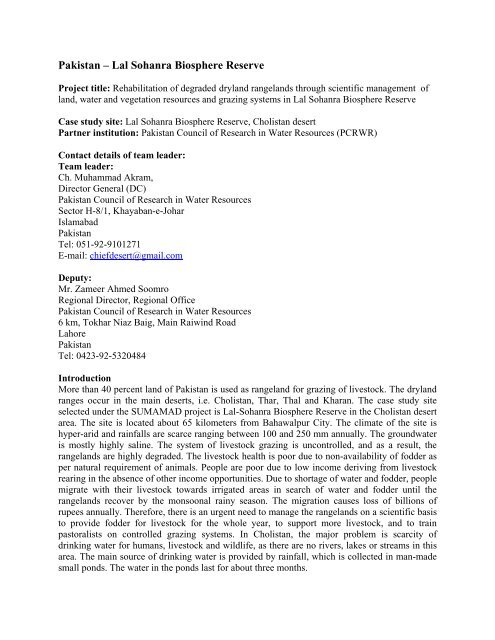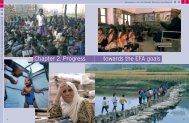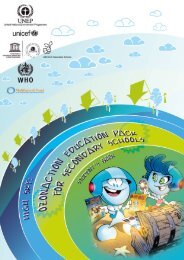Pakistan â Lal Sohanra Biosphere Reserve - Unesco
Pakistan â Lal Sohanra Biosphere Reserve - Unesco
Pakistan â Lal Sohanra Biosphere Reserve - Unesco
Create successful ePaper yourself
Turn your PDF publications into a flip-book with our unique Google optimized e-Paper software.
<strong>Pakistan</strong> – <strong>Lal</strong> <strong>Sohanra</strong> <strong>Biosphere</strong> <strong>Reserve</strong><br />
Project title: Rehabilitation of degraded dryland rangelands through scientific management of<br />
land, water and vegetation resources and grazing systems in <strong>Lal</strong> <strong>Sohanra</strong> <strong>Biosphere</strong> <strong>Reserve</strong><br />
Case study site: <strong>Lal</strong> <strong>Sohanra</strong> <strong>Biosphere</strong> <strong>Reserve</strong>, Cholistan desert<br />
Partner institution: <strong>Pakistan</strong> Council of Research in Water Resources (PCRWR)<br />
Contact details of team leader:<br />
Team leader:<br />
Ch. Muhammad Akram,<br />
Director General (DC)<br />
<strong>Pakistan</strong> Council of Research in Water Resources<br />
Sector H-8/1, Khayaban-e-Johar<br />
Islamabad<br />
<strong>Pakistan</strong><br />
Tel: 051-92-9101271<br />
E-mail: chiefdesert@gmail.com<br />
Deputy:<br />
Mr. Zameer Ahmed Soomro<br />
Regional Director, Regional Office<br />
<strong>Pakistan</strong> Council of Research in Water Resources<br />
6 km, Tokhar Niaz Baig, Main Raiwind Road<br />
Lahore<br />
<strong>Pakistan</strong><br />
Tel: 0423-92-5320484<br />
Introduction<br />
More than 40 percent land of <strong>Pakistan</strong> is used as rangeland for grazing of livestock. The dryland<br />
ranges occur in the main deserts, i.e. Cholistan, Thar, Thal and Kharan. The case study site<br />
selected under the SUMAMAD project is <strong>Lal</strong>-<strong>Sohanra</strong> <strong>Biosphere</strong> <strong>Reserve</strong> in the Cholistan desert<br />
area. The site is located about 65 kilometers from Bahawalpur City. The climate of the site is<br />
hyper-arid and rainfalls are scarce ranging between 100 and 250 mm annually. The groundwater<br />
is mostly highly saline. The system of livestock grazing is uncontrolled, and as a result, the<br />
rangelands are highly degraded. The livestock health is poor due to non-availability of fodder as<br />
per natural requirement of animals. People are poor due to low income deriving from livestock<br />
rearing in the absence of other income opportunities. Due to shortage of water and fodder, people<br />
migrate with their livestock towards irrigated areas in search of water and fodder until the<br />
rangelands recover by the monsoonal rainy season. The migration causes loss of billions of<br />
rupees annually. Therefore, there is an urgent need to manage the rangelands on a scientific basis<br />
to provide fodder for livestock for the whole year, to support more livestock, and to train<br />
pastoralists on controlled grazing systems. In Cholistan, the major problem is scarcity of<br />
drinking water for humans, livestock and wildlife, as there are no rivers, lakes or streams in this<br />
area. The main source of drinking water is provided by rainfall, which is collected in man-made<br />
small ponds. The water in the ponds last for about three months.
The main stakeholders are Cholistani people, the <strong>Pakistan</strong> Council for Research in Water<br />
Resources (PCRWR), and Cholistan Development Authority (CDA) which are working for the<br />
development of dryland resources. PCRWR and CDA have excavated and constructed some 200<br />
big earthen reservoirs. In total, about one thousand small and big reservoirs exist in the area.<br />
Evaporation causes huge water loss from these water bodies estimated at about 40 per cent of the<br />
storage capacity of the ponds. Therefore, this project has been selected for the second phase of<br />
the SUMAMAD project to use existing land and water resources in order to develop excellent<br />
rangelands in Cholistan and <strong>Lal</strong>-<strong>Sohanra</strong> <strong>Biosphere</strong> <strong>Reserve</strong>. The overall aim is to introduce<br />
controlled grazing systems and to manage these systems sustainably. The free grazing pattern<br />
and land use will be converted in to controlled rotational grazing system. This will generate<br />
many livelihood sources for local people in the form of; labour for livestock farms, milk, meat<br />
and leather products. The increase in vegetation cover as a result of project activities i.e.<br />
reseeding of ranges and application of irrigation during dry period will enhance overall green<br />
cover. It will help in reducing temperature and increasing oxygen in the air and absorbing carbon<br />
dioxide gases making regional environment more friendly for human and livestock population.<br />
Properly developed rangeland will increase economic value of drylands. The experiments to be<br />
carried out with the support of SUMAMAD project on management of rangelands and controlled<br />
grazing systems will play role of model for the Cholistan Development Authority (CDA) to be<br />
adopted by her on large scale. The CDA is a semi-autonomous body to deal with the desert and<br />
is independent to formulate a policy for themselves. Therefore, range management and<br />
development for the Cholistan desert will be adopted easily.<br />
Justification<br />
About 14 per cent of <strong>Pakistan</strong>’s land area consists of deserts and drylands. These lands are used<br />
for grazing of livestock which is the primary source of income for the people. Agriculture is not<br />
practiced due to the lack of irrigation water from rivers, dams or lakes. Little and erratic<br />
precipitation is a problem, and its distribution does not match crop growing seasons and crop<br />
water requirement periods. To increase livestock production, good drinking water and good<br />
rangelands are needed, but they are in poor condition due to mismanagement and lack of<br />
scientific knowledge. These issues need to be addressed by the scientific community to find out<br />
solutions regarding degraded rangelands and water loss due to evaporation. There is an urgent<br />
need to increase the carrying capacity in rangelands and to enhance the water storage capacity of<br />
ponds in the dryland of Cholistan. It is hoped that the degraded rangelands can be converted into<br />
excellent grassland as a model for adoption on different scales by the farmers and CDA.<br />
Achievement/Lesson Learned from 1 st Phase of SUMAMAD<br />
The SUMAMAD project studies carried out at <strong>Lal</strong> <strong>Sohanra</strong> <strong>Biosphere</strong> <strong>Reserve</strong> during the first<br />
project phase pointed out specific problems which are directly linked to societal patterns and<br />
drought impacts. Economic resources and aspirations of the people have been identified. The<br />
people’s views to resolve their economic and environmental issues were enlisted to understand<br />
the project area more realistically. The studies helped policy-makers to identify and initiate better<br />
development projects in the area in the fields of water resources, roads, education, electricity<br />
supply etc. The projects on income generating activities, i.e. saline fish farming as an alternative<br />
livelihood option and income opportunity for dryland people, vegetable production using saline<br />
water, and moisture conservation techniques provided new concepts to policy-makers to invest in<br />
2
development projects that may bring dryland dwellers at par with the society in the developed<br />
parts of the country. The lessons learned from the SUMAMAD project phase-1 is that priority<br />
should be given to address community problems and to solicit the cooperation of dryland people<br />
so as to implement innovative techniques for the management of dryland resources.<br />
Objectives<br />
1. To rehabilitate degraded rangelands of Cholistan dryland by scientific management of<br />
land, water and vegetation resources.<br />
2. To halt degradation of rangelands by adopting protective measures to enhance<br />
carrying capacity.<br />
3. Introduction of a new concept of rangeland irrigation through a sprinkler system<br />
during the dry season using rainwater storages or groundwater to increase biomass<br />
production.<br />
4. To enhance livestock production in drylands by providing more fodder per unit area.<br />
5. To increase income of livestock owners residing in the dryland to improve their living<br />
conditions.<br />
6. To investigate the most economical, sustainable and site specific ways to minimize<br />
water evaporation loss from rainwater-fed earthen ponds.<br />
Measures and activities<br />
An area of about twenty hectares will be selected in Cholistan desert for the management of<br />
rangeland. Before starting the research activities, data about the range will be collected for the<br />
parameters (1) soil texture up to 60 cm, (2) infiltration, (3) WHC, (4) EC, (5) pH, (6) ESP, (7)<br />
vegetation canopy, (8) vegetation species, (9) palatable and un-palatable vegetation, (10) grass<br />
species, (11) vegetation biomass, (12) palatable biomass, (13) un-palatable biomass, and (14)<br />
carrying capacity. There are two sprouting seasons in Cholistan which occur during the spring<br />
and summer monsoon. It is a general trend in <strong>Pakistan</strong>’s deserts that if winter rainfall occurs in<br />
the months of January and February, the grass sprouts from the middle of February and matures<br />
until the end of April. Similarly in the summer monsoon season, the grass again sprouts in<br />
August and matures in the month of November. Keeping in view the above trend, a study has<br />
been designed to apply irrigation supplements in both sprouting seasons to compare the biomass<br />
obtained with and without irrigation. To fix a benchmark for optimum application of irrigation,<br />
different numbers of irrigation schemes will be applied. At the end, water productivity and<br />
monetary value of water will be calculated to choose the best fit quantity of water application.<br />
The study will be based on three major experiments:<br />
Experiment-1<br />
There will be eight different treatments:<br />
(1) T 1 Natural grazing land<br />
(2) T 2 Fencing of natural grazing land<br />
(3) T 3 Fencing and reseeding of grasses in the rainy season<br />
3
(4) T 4 Reseeding of open grazing land without fencing<br />
(5) T 5 Fencing plus reseeding plus spray irrigation during sprouting season<br />
(6) T 6 Fencing plus reseeding plus irrigation on monthly basis<br />
(7) T 7 Fencing plus reseeding plus irrigations with interval of two months<br />
(8) T 8 Fencing plus reseeding plus irrigation with interval of 3 months.<br />
The following data will be collected:<br />
• Soil: Texture, EC, pH, ESP of soil profile up to 60 cm infiltration.<br />
• Water quality: EC, pH, SAR, RSC.<br />
• Irrigation: Depth of irrigation (mm)<br />
• Climatic data: Temperature, humidity, wind speed, evaporation, ET, rainfall.<br />
• Vegetation data before and after each six months: Wet biomass per unit area;<br />
• Dry biomass per unit areas, vegetation species, vegetation canopy cover, palatable<br />
vegetation biomass wet and dry<br />
• Carrying capacity<br />
• Cost of irrigations and other practices<br />
• Production and income of rangeland in the form of animal units.<br />
Experiment-2<br />
(1) T 1 Uncontrolled grazing by sheep<br />
(2) T 2 Uncontrolled grazing by goats<br />
(3) T 3 Uncontrolled grazing by cattle<br />
(4) T 4 Uncontrolled grazing by camels<br />
(5) T 5 Controlled rotational grazing by sheep<br />
(6) T 6 Controlled rotational grazing by goats<br />
(7) T 7 Controlled rotational grazing by cattle<br />
(8) T 8 Controlled rotational grazing by camels.<br />
Data to be collected:<br />
(1) Canopy<br />
(2) Biomass<br />
(3) Vegetation species<br />
(4) Palatable species<br />
(5) Un-palatable species<br />
(6) Carrying capacity<br />
Experiment-3<br />
Evaporation will be controlled by using different local, economical and sustainable materials.<br />
The following treatments will be adopted.<br />
(1) T 1 100% seepage control without control of evaporation<br />
(2) T 2 100% seepage control with evaporation control by thermopore grains<br />
(3) T 3 100% seepage control with evaporation control by green net<br />
(4) T 4 100% seepage control with evaporation control by ceiling with tinsheet<br />
(5) T 5 100% seepage control and evaporation control by ceiling with local material, i.e. bamboo<br />
or wood and vegetation etc.<br />
4
Data to be recorded:<br />
(1) Climate<br />
(2) Pan evaporation<br />
(3) Water depth<br />
(4) Water loss<br />
(5) Water quality analysis.<br />
Expected Outputs<br />
After improving degraded rangelands of Cholistan, the carrying capacity should increase up to<br />
ten times more than natural degraded ranges. It will increase livestock production in the form of<br />
milk, meat, leather etc. It will increase income of the people as well as stop land degradation and<br />
control desertification for future generations. The reduction of evaporation losses from ponds<br />
will increase water quantity to be used for irrigation. Further fodder requirement for livestock<br />
will be reduced and pressure on the ranges will be decreased to stop their degradation and it will<br />
help for controlling desertification. The study falls under SUMAMAD scientific studies relating<br />
to the following key subjects.<br />
• Improvement of dryland agriculture including rangelands and livestock, with biodiversity<br />
and sustainable use of natural resources as a minor component.<br />
• Restoration/rehabilitation of degraded drylands including sustainable water conservation<br />
and harvesting practices.<br />
Work Plan<br />
The experiments on rangeland management and grazing systems will be carried out in the first<br />
three years. This part of the study will be completed in all respects by covering all steps, i.e. site<br />
selection, application of field treatments as per layout, data collection, data compilation, data<br />
analysis and report writing. The 2 nd part of study, i.e. experiment-3 control of evaporation, will<br />
be carried out at the start of the 4 th year and will be completed by the end of the 5 th year covering<br />
all steps, field experimentation, data collection, compilation and report writing.<br />
S.No.<br />
Project Activities<br />
1 Rangeland development<br />
2 Grazing systems<br />
3 Evaporation control<br />
Period (Years)<br />
1 2 3 4 5<br />
Work Plan for 1 st Year<br />
S.No. Activities<br />
1 Site selection and<br />
surveys<br />
2 Fencing of the area<br />
3 Reseeding<br />
4 Irrigation<br />
5 Data collection<br />
6 Data analysis<br />
1 st Year (Months)<br />
1 2 3 4 5 6 7 8 9 10 11 12<br />
5
7 Report preparation<br />
Team Composition<br />
S.No. Name Designation Field Expertise Experience<br />
(Years)<br />
1 Dr. Muhammad Akram<br />
Kahlown, Chairman, PCRWR,<br />
Islamabad<br />
2 Ch. Muhammad Akram, Chief<br />
Research (Desertification),<br />
PCRWR, Islamabad<br />
3 Mr. Zamir Ahmed Soomro,<br />
Regional Director, PCRWR,<br />
Bahawalpur.<br />
4 Mr. Muhammad Tahir Saleem,<br />
ARO, PCRWR, Bahawalpur<br />
National<br />
Coordinator<br />
(Team Leader)<br />
Deputy Team<br />
Leader<br />
Senior<br />
Researcher<br />
Junior<br />
Researcher<br />
Water Resources<br />
Management<br />
32<br />
Rainwater Harvesting 30<br />
Rangeland, Saline<br />
Agri. Desertification<br />
Control<br />
Water Resources<br />
15<br />
Management and<br />
Desertification<br />
Control<br />
Agronomy 10<br />
Role in the project<br />
S.No. Name Role in Project<br />
1 Dr. Muhammad Akram Kahlown,<br />
Chairman, PCRWR<br />
Overall guidance as per SUMAMAD<br />
instructions.<br />
2 Ch. Muhammad Akram,<br />
Chief Research (Desertification)<br />
• To develop concepts of research<br />
proposals considering needs and<br />
necessity of the local people and project<br />
site beneficial to project site to uplift<br />
the socio-economic conditions of the<br />
area.<br />
• To plan, design and write up the<br />
research proposals to be submitted to<br />
the SUMAMAD.<br />
• To prepare layout of the proposals to be<br />
implemented in the field and list out<br />
parameters to be recorded during the<br />
period of study.<br />
• To provide guidance to the research<br />
team for collection of data and process<br />
the same to be reportable in the final<br />
report.<br />
• To finalize research data of the study to<br />
be incorporated in the report.<br />
• To write up report about the research<br />
results obtained from project study.<br />
6
• To prepare technical paper from the<br />
study report to be presented in the<br />
SUMAMAD seminars by the National<br />
Coordinator.<br />
3 Mr. Zamir Ahmed Soomro,<br />
Regional Director,<br />
PCRWR, Bahawalpur.<br />
4 Mr. Muhammad Tahir Saleem,<br />
ARO, PCRWR, Bahawalpur<br />
Data collection and compilation<br />
Field data collection<br />
Estimated Budget for 5 Years<br />
S.No. Particulars Estimated Costs<br />
(in US$)<br />
1 Fencing material and its installation 10,000<br />
2 Reseeding of ranges 15,000<br />
3 Irrigation system installation 15,000<br />
4 Excavation small pits and material for seepage<br />
15,000<br />
and evaporation control.<br />
5 Transport charges 5,000<br />
6 TA/DA of technical experts 15,000<br />
7 POL for irrigation system 5,000<br />
8 Stationary, Laptop and contingencies 10,000<br />
9 Seminars 20,000<br />
Total 110,000<br />
Expenditure from local sources for 5 years<br />
S.No. Item Estimated costs<br />
(in US$)<br />
1 Deep tubewell installation 30,000<br />
2 Fencing material and installation 20,000<br />
3 Filed staff salary 50,000<br />
4 Reseeding of ranges 20,000<br />
5 Excavation of pits and seepage + evaporation<br />
20,000<br />
control materials<br />
6 Miscellaneous 10,000<br />
Total 150,000<br />
Counterpart contribution per year (in US Dollars):<br />
2009 2010 2011 2012 2013 Total<br />
SUMAMAD<br />
Member State<br />
30,000 30,000 30,000 30,000 30,000 150,000<br />
7

















